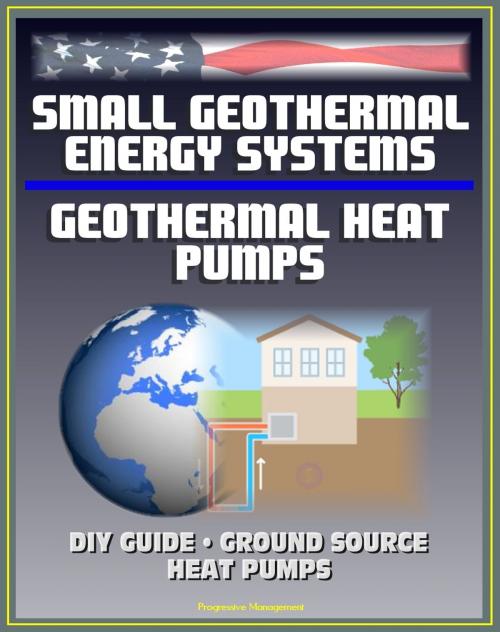Small Geothermal Energy Systems and Geothermal Heat Pumps: Guide for the Do-it-Yourselfer (DIY), Ground Source Heat Pumps, Information Survival Kit for Heat Pump Owners, Energy Program Successes
Nonfiction, Science & Nature, Technology, Environmental, Power Resources| Author: | Progressive Management | ISBN: | 9781476446752 |
| Publisher: | Progressive Management | Publication: | April 25, 2012 |
| Imprint: | Smashwords Edition | Language: | English |
| Author: | Progressive Management |
| ISBN: | 9781476446752 |
| Publisher: | Progressive Management |
| Publication: | April 25, 2012 |
| Imprint: | Smashwords Edition |
| Language: | English |
This comprehensive compilation of DOE documents provides unique and practical information about geothermal heat pumps, including small geothermal systems and DIY systems.
Contents: Chapter 1: Small Geothermal Systems: A Guide For The Do-It-Yourselfer * Chapter 2: Using The Earth To Heat and Cool Buildings * Chapter 3: An Information Survival Kit For The Prospective Geothermal Heat Pump Owner * Chapter 4: Success Stories of the Geothermal Energy Program * Chapter 5: Ground-Source Heat Pumps: Overview of Market Status, Barriers to Adoption, and Options for Overcoming Barriers
A heat pump—like an air conditioner or refrigerator—moves heat from one place to another. In the summer, a geothermal heat pump (GHP) operating in a cooling mode lowers indoor temperatures by transferring heat from inside a building to the ground outside or below it. Unlike an air conditioner, though, a heat pump's process can be reversed. In the winter, a GHP extracts heat from the ground and transfers it inside. Also, the GHP can use waste heat from summer air-conditioning to provide virtually free hot-water heating. The energy value of the heat moved is typically more than three times the electricity used in the transfer process. GHPs are efficient and require no backup heat because the earth stays at a relatively moderate temperature throughout the year. A GHP system has three major components: a ground loop (buried piping system), the heat pump itself (inside the house), and a heating and cooling distribution system. There are two main types of GHP systems. The earth-coupled (or closed-loop) GHP uses sealed horizontal or vertical pipes as heat exchangers through which water, or water and antifreeze, transfer heat to or from the ground. The second type, the water-source (or open-loop) GHP, pumps water from a well or other source to the heat exchanger, then back to the source. Because of their versatility, earth-coupled systems dominate the GHP market. Typical loop installations for the earth-coupled systems are expected to work for 50 years. More than 400,000 GHPs are operating in homes, schools, and commercial buildings in the United States. They are adaptable to virtually any kind of building; the Federal government has installed nearly 10,000 GHPs.
Geothermal resources are available across the United States at varying depths, providing a ubiquitous buried treasure of domestic renewable energy. Enormous amounts of hydrothermal geothermal energy is available in the western United States, but theoretically, geothermal sources are available across the United States. The key to being able to use geothermal energy is to find a way to enhance geothermal systems lacking key natural characteristics. Natural geothermal systems depend on three factors to produce energy: heat, water, and permeability. While heat is present virtually everywhere at depth, water and permeability are less abundant. Geothermal technology is an attractive renewable resource because it can provide a constant source of renewable baseload electricity. While the sun and wind offer a large potential source of renewable energy that varies over time, geothermal technology is uninterruptible and can provide a stable baseload form of energy while diversifying the nation’s renewable portfolio. Geothermal energy has low environmental risk and impact. When used with a closed-loop binary power plant, geothermal systems emit zero greenhouse gas emissions and have a near zero environmental risk or impact.
This comprehensive compilation of DOE documents provides unique and practical information about geothermal heat pumps, including small geothermal systems and DIY systems.
Contents: Chapter 1: Small Geothermal Systems: A Guide For The Do-It-Yourselfer * Chapter 2: Using The Earth To Heat and Cool Buildings * Chapter 3: An Information Survival Kit For The Prospective Geothermal Heat Pump Owner * Chapter 4: Success Stories of the Geothermal Energy Program * Chapter 5: Ground-Source Heat Pumps: Overview of Market Status, Barriers to Adoption, and Options for Overcoming Barriers
A heat pump—like an air conditioner or refrigerator—moves heat from one place to another. In the summer, a geothermal heat pump (GHP) operating in a cooling mode lowers indoor temperatures by transferring heat from inside a building to the ground outside or below it. Unlike an air conditioner, though, a heat pump's process can be reversed. In the winter, a GHP extracts heat from the ground and transfers it inside. Also, the GHP can use waste heat from summer air-conditioning to provide virtually free hot-water heating. The energy value of the heat moved is typically more than three times the electricity used in the transfer process. GHPs are efficient and require no backup heat because the earth stays at a relatively moderate temperature throughout the year. A GHP system has three major components: a ground loop (buried piping system), the heat pump itself (inside the house), and a heating and cooling distribution system. There are two main types of GHP systems. The earth-coupled (or closed-loop) GHP uses sealed horizontal or vertical pipes as heat exchangers through which water, or water and antifreeze, transfer heat to or from the ground. The second type, the water-source (or open-loop) GHP, pumps water from a well or other source to the heat exchanger, then back to the source. Because of their versatility, earth-coupled systems dominate the GHP market. Typical loop installations for the earth-coupled systems are expected to work for 50 years. More than 400,000 GHPs are operating in homes, schools, and commercial buildings in the United States. They are adaptable to virtually any kind of building; the Federal government has installed nearly 10,000 GHPs.
Geothermal resources are available across the United States at varying depths, providing a ubiquitous buried treasure of domestic renewable energy. Enormous amounts of hydrothermal geothermal energy is available in the western United States, but theoretically, geothermal sources are available across the United States. The key to being able to use geothermal energy is to find a way to enhance geothermal systems lacking key natural characteristics. Natural geothermal systems depend on three factors to produce energy: heat, water, and permeability. While heat is present virtually everywhere at depth, water and permeability are less abundant. Geothermal technology is an attractive renewable resource because it can provide a constant source of renewable baseload electricity. While the sun and wind offer a large potential source of renewable energy that varies over time, geothermal technology is uninterruptible and can provide a stable baseload form of energy while diversifying the nation’s renewable portfolio. Geothermal energy has low environmental risk and impact. When used with a closed-loop binary power plant, geothermal systems emit zero greenhouse gas emissions and have a near zero environmental risk or impact.















